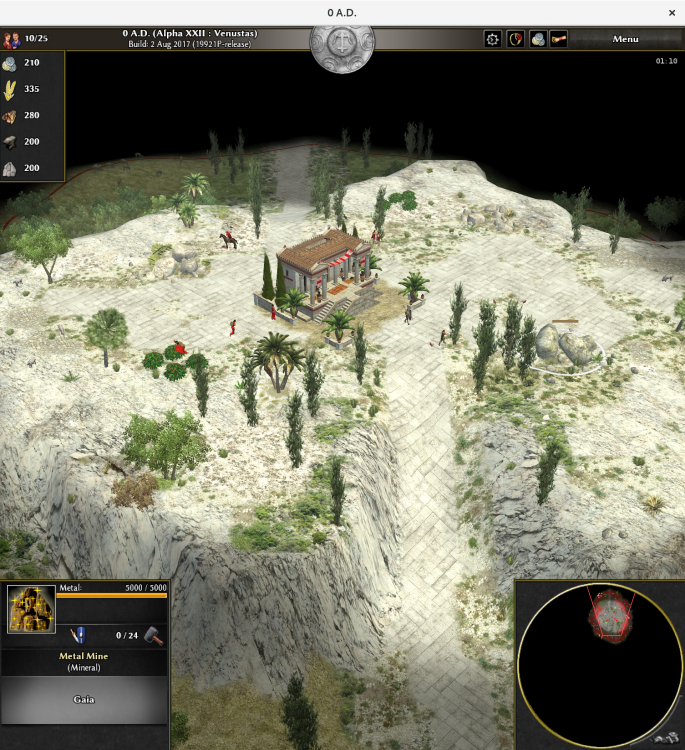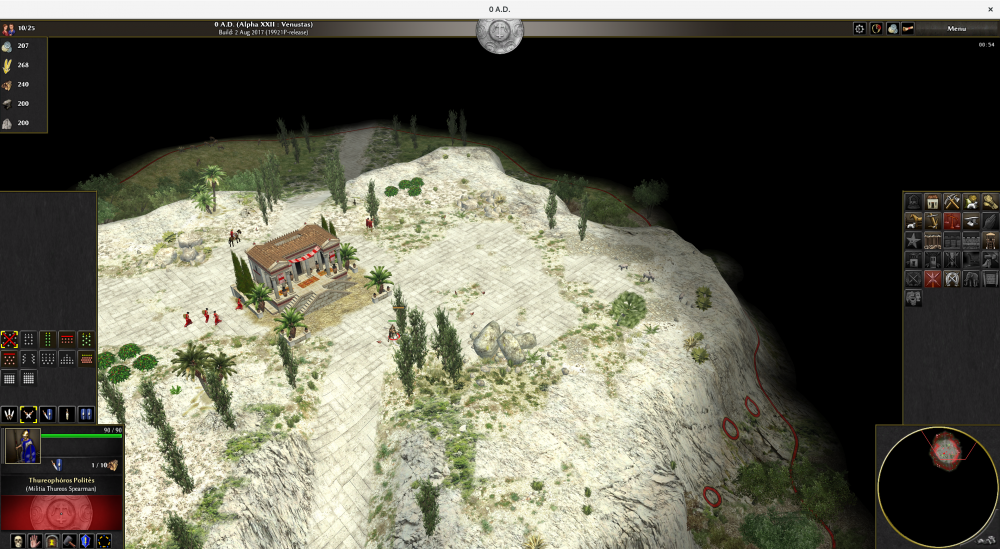-
Posts
2.300 -
Joined
-
Days Won
23
Everything posted by Nescio
-
(And let's assume it's an aquila heliaca): (This one is also spectacular):
-
Well, I agree the eagle's talons on those Ptolemaic coins are not always clear, however, I believe the idea is that it has two or three fingers pointing forward and one backwards around Zeus' thunderbolt. The eye is also quite prominent, sometimes. A few examples of varying quality:
-
Sorry to be interrupting, but although I do like the colour, the bird is problematic: its talons are orientated in a wierd direction, its breast looks a bit flat, and its eye has disappeared. Please compare your angry bird with the noble raptor of the original post:
-
Quite frankly, I never understood "mini-civs". Anyway, additional civilizations would always be nice, but let's return to what this discussion is about, new features.
- 202 replies
-
- a24
- new features
-
(and 1 more)
Tagged with:
-
Mauryas and Kushites were deemed good enough to be included, so yes, out of curiosity, what is wrong with the Han? Personally I'd favour broadly a c. 800 B.C. to 200 A.D. timeframe for part I (Eurasian Iron Age) and a c. 284 (start Diocletian reforms) to 800 (Charlemagne crowned emperor) for part II (Late Antiquity and Early Middle Ages). But that's a different discussion However, Scythians and Parthians (they peaked before 100 B.C.) are certainly necessary to fill the gaps in 0 A.D.'s current timeframe. Illyrians, Thracians, Dacians, Pontus, Armenians, and Numidians would be nice too, although they were largely regional (but more important than Britons or Iberians).
- 202 replies
-
- 2
-

-
- a24
- new features
-
(and 1 more)
Tagged with:
-
A23 has not been released yet and we're already discussing A24? A few things I'd like to see eventually: make adding, renaming, or removing damage types as easy as changing resources; hack/pierce/crush is currently hard-coded; if one were to make a fantasy mod, he'd probably want to have different damage types, e.g. fire, ice, lightning, poison, etc. add an option to switch to a simplified mini-map, hiding the terrain background, displaying only actors display resource gatherer counts ( https://trac.wildfiregames.com/ticket/643 ) replace Petra's hardcoded structure template paths with classes or something else template-independent set random maps as the default map type, instead of skirmishes Why not? They did peak in the 200-1 B.C. timeframe, interacted with other Eurasian empires (Parthians, Romans), and were possibly the most important states to exist at the time.
- 202 replies
-
- 2
-

-
- a24
- new features
-
(and 1 more)
Tagged with:
-
The consensus is the Trojan War took place somewhere around 1200 B.C.; Britannia (Roman Great Britain) started with Claudius' invasion in 43 A.D. So unless both series are about something else than their titles suggest, they are actually outside our current timeframe (500-1 B.C.).
-
Yes, please! This would also allow phasing out phases If I recall correctly, something like the following was present in Rise of Nations. Settlements started out as a town and have both a (large) territory radius and a (smaller) city radius. Markets and civic structures could only be build within the city radius, whereas defensive, military, and gathering structures could be placed anywhere in your territory. Once a certain number of different structures (e.g. 5) was present within the inner radius, an individual town would automatically upgrade to a city, which has increased health, attack, territory influence, and a larger city radius. When the number of different structures within a city radius was doubled (e.g. 10), the city was automatically improved to a metropolis, again with increased health, attack, territory influence, and a larger settlement radius. Furthermore, some structures also affected city stats, e.g. temple increases capture points by 50%. Also, there were many wonders, each with different bonuses, but they were civilization-independent; each wonder could be constructed only once per map/campaign.
- 202 replies
-
- 2
-

-
- a24
- new features
-
(and 1 more)
Tagged with:
-
And population makes seven; now try displaying all of them on half a 1024 pixel screen
-
Actually I'm not convinced introducing yet another type of mine would be a good idea. Nor do I like the groves (basically wood mines) suggestion. I think different resources ought to be acquired in different ways. Also, non-gatherable cash/coins/currency/electron/gold/silver/whatever, obtainable via barter, trade, looting, taxation (trickle), already works. So gold mines, no thanks. I've contemplated removing metal mines, for reasons of gameplay and realism. The former because if mines are exhausted, (AI) players are no longer really effective; also, it forces every map to include at least a certain number of mines per player. The latter because in reality not all materials are available in every area. Bricks would be nice, as would having iron and bronze instead of "metal", and introducing textiles (wool, flax and linen, cotton, leather, etc.). Unfortunately 0 A.D. is not really designed for having many resources. Having just one type of resource (money) might even work better.
-

===[TASK]=== Greek Unit Texture (General Thread)
Nescio replied to wackyserious's topic in Official tasks
Great! The Kausia should probably be used by pikemen and maybe by support units as well. A Macedonian phalangite (pikeman): A Macedonian thureophoros/thorakites: -
-
A few things I really hope will be eventually included in 0 A.D.: make adding, renaming, or removing damage types as easy as changing resources; hack/pierce/crush is currently hard-coded; if one were to make a fantasy mod, he'd probably want to have different damage types, e.g. fire, ice, lightning, poison, etc. have a generic armour, which applies to all damage types, unless otherwise specified display gatherer counts ( https://trac.wildfiregames.com/ticket/643 ) automatically display attack multipliers (cf. auras) and remove the need to manually specify bonus attacks in tooltip strings I guess these features have been requested before, but it doesn't hurt asking again
-

===[TASK]=== Greek Unit Texture (General Thread)
Nescio replied to wackyserious's topic in Official tasks
Not crustaceans (crabs, lobsters, and shrimps), but sea snails. Also, the our modern word “purple” is very limited; the purple dye could actually generate a whole spectrum of shades from pink to red to brown and everything in between. The darker the colour, the more dye was required, so a black robe would be even more expensive than a faintly purple one. Other very expensive dyes in Antiquity, besides Tyrian purple, were: carmine (crimson, scarlet), probably originating in Armenia, made from Kermes and related beetle scales, which produced intensely bright shades of red; nowadays it's still used for cardinal robes and red M&Ms. saffron, possibly originating in Greece, made from flower threads, which produced warm golden shades of yellow; it was and still is very important in Greater Persia/Iran indigo, won independently in several areas around the world, including India, produced from flowers of the Indigofera plants, which produced shades of blue; jeans are coloured with (synthetic) indigo today On the other hand, there were many other cheap, widely available, and locally produced dyes, such as charcoal, henna, ochre, ox blood, woad, etc. -
Helmets continued to be made from bronze, not iron. Also, the Corinthian helmet is more characteristic of the Archaic period (800-500 B.C.). In 0 A.D's timeframe most Greek hoplites preferred more open helmets such as the Illyrian, Chalcidian, and later Attic types. And Spartans frequently used the simple, conical pilos instead.
-
0abc updated several times; changes include amongst many other things: attempts to improve balance at different levels reduced the number of bonus attacks soldiers and warships no longer grant resource loot soldier subtypes: citizen militia: default stats mercenary: +1 h/p/c armour, +10% health, +20% attack veteran regular: +2 h/p/c armour, +20% health, +50% attack champion guard: +3 h/p/c armour, +50% health, +100% attack heroes and team bonuses are disabled redid many civilization bonuses many other minor tweaks, corrections, reorganizations, improvements, etc As usual, have a look at 0abc-readme.pdf
-
Templates typically inherit from others; open any xml template and have a look at the second line, all the information you need is there: <Entity parent="*"> Unless a new value is specified in a template, the child has the same values as its parents. Basically all unit templates form a tree; e.g.: template_unit.xml template_unit_cavalry.xml template_unit_cavalry_ranged.xml template_unit_cavalry_ranged_javelinist.xml units/athen_cavalry_javelinist_b.xml units/athen_cavalry_javelinist_a.xml units/athen_cavalry_javelinist_e.xml
-

Skirmish map - Egypt (previously "Egypt condensed")
Nescio replied to mimesot's topic in Scenario Design/Map making
“Aegyptos” is a chimaera; correct it to “Aigyptos” (Greek spelling) or “Aegyptus” (Latin spelling); or just keep “Egypt” (English spelling). -
Out of curiosity, how do you make those actor-based unit icons?
-

Gameplay Feature: Mercenary and Mercenary Camp
Nescio replied to wowgetoffyourcellphone's topic in Delenda Est
What was the result of your kush experiment? And won't the following production queue work? {civ}_infantry_swordsman_merc_b {civ}_infantry_archer_merc_b {civ}_cavalry_spearman_merc_b kush_mercenary_camelry_1 (Again, I haven't actually tried modding A23 yet.) Actually I don't think you need to create additional simulation/data/civs/*.json files. Those don't exist for the `gaia` and `skirm` civs either, yet you can set a template to those. -

Gameplay Feature: Mercenary and Mercenary Camp
Nescio replied to wowgetoffyourcellphone's topic in Delenda Est
Although I haven't tried modding A23 yet, D1084 seems quite clear to me. Suppose a mace player captured a pers centre with the following production queue: units/{native}_female_citizen units/{civ}_infantry_spearman_b units/{civ}_infantry_archer_b units/{civ}_cavalry_javelinist_b Then the player (mace) can train there two units: a pers female (because structure {native} is pers) and a mace cavalry javelinist (because owner {civ} is mace). The other two do not exist, because mace has pikemen and javelinists instead of citizen archers and spearmen. -
The fire ship actually does not have an aura. Yes, it's possible to drain health from nearby units; try e.g. drain_health.json As far as I understood it, lag has primarily to do with the pathfinder. I doubt auras have any effect on the game's speed.
-
Thank you for your quick replies! Take your time, it's just a nice to have in the long run
-

Unit And Building Names
Nescio replied to Davarish's topic in Game Development & Technical Discussion
But then we should also write Old Persian names in Old Persian cuneiform and Carthaginian in the Phoenician alphabet. Although it's possible, I'm unconvinced that would be a good idea. (Different writing directions also tend to complicate things.) -
@Alexandermb, @LordGood, @stanislas69, would it be possible to give cavalry a (short) loop rein? Minor details such as this make the game more enjoyable, at least for some people. Closed reins are well attested throughout Eurasia (even for horse archers): Greece: Romans: Han China: Bactria: India: (Yes, I believe I've requested this before somewhere, I don't recall where exactly, hence me starting a new thread).





